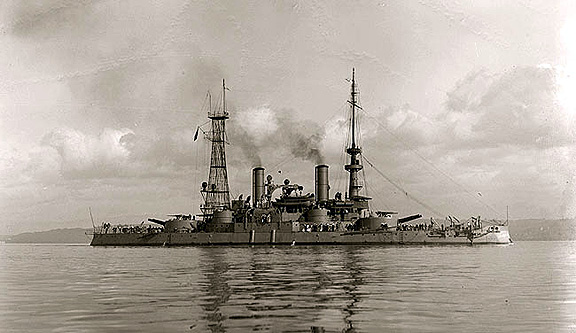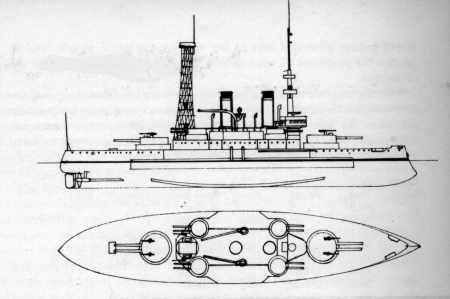

Courtesy: San Diego State University
Above: An excellent side photograph of the USS Oregon BB-03 arriving in San Diego, California. By the time this photograph was taken, newer and more powerful battleships had succeeded in making the USS Oregon and her sisters of the USS Indiana Class obsolete. Note the after mast and anti-torpedo boat destroyer guns on the thirteen inch turrets. This photograph provides a good representation of the small length of the ship. The square structure between the aft mast and the aft stack is a newly installed radio room (shack).
Although the Indiana was one of the most powerful warships ever
built by the United States at that time, she did have her drawbacks.
The Indiana had a low freeboard, meaning her decks were frequently
awash, and tended to roll when under normal steaming conditions. Also,
because of the size of her main battery, a full broadside from her four
thirteen inch rifles would roll the ship even further. This was eventually
corrected by retrofitting the ship with bilge keels. As compared to the
modern warships of today, living conditions were spartan at best and because
coal was the source of fuel for the engineering plant, work was particularly
dirty and dangerous because of the danger of spontaneous combustion.
| Ship | Laid Down | Launched | Completed | Built By |
| BB-01 Indiana | 07 May 1891 | 28 February 1893 | November 1895 | Cramp Shipyard |
| BB-02 Massachusetts | 05 June 1891 | 10 June 1893 | June 1896 | Cramp Shipyard |
| BB-03 Oregon | 19 November 1891 | 26 October 1893 | 15 July 1896 | Union Iron Works |
General Low freeboard coast-defense battleships, the first vessels of the United States Navy which approached their foreign contemporaries in fighting power. All three served in the Spanish-American War of 1898 in which the Oregon distinguished herself. With their low freeboard they were not suitable for North Atlantic duties, and they were relegated to secondary duties during World War I.
The Indianas were authorised in 1890, and their protection was designed to equal the British Royal Sovereign class. Although intended to have ordinary nickel steel armor, they were given some of the latest Harvey steel, which only became available after they had been laid down. The secondary 8" guns had 8 1/2" of armor and initiated a new phase of heavy secondary armaments in all navies.
In addition to the 8" guns, the Indianas also carried four 6" guns in casemates at forecastle deck level, but inevitably this weight of armament on a displacement of only 10,000 tons meant that the guns were too close together. Blast from the 6" guns interfered with the 13" gun crews, and in turn 13" gun blasts affected the crews of the 6" guns. For this reason the 6" guns were replaced in 1911 by 3".
Armament Both 8" and 13" turrets had all-round loading, which was in advance of contemporary European designs, but as they were not balanced the main turrets tended to make the ship heel when the turrets were trained abeam. On one occasion in this class a forward turret broke adrift in a heavy gale. In 1918 eight 3" guns were removed to arm merchantmen.
Appearance During their modernization in 1909-11 all three had the famous 'cage' or 'basket'.type mast fitted in place of the pole mainmast.
Careers
Indiana: Paid off in May 1914 at Philadelphia, but recommissioned
24 May 1917 as gunnery training ship on East Coast, based on York River,
Virginia until decommissioned in January 1919; reclassified as Coast
Battleship No. 1 to release her name for a new battleship, and sunk
as a target 1 November 1920; hull raised and sold for scrap in 1924.
Massachusetts: Paid off in May 1914 but recommissioned 09 June 1917 at Philadelphia Navy Yard to serve as gunnery training ship at Newport from October 1917 to May 1918; repaired at Philadelphia followed by further training duties with 'A' Division of Battleship Force I, U.S. Atlantic Fleet; decommissioned March 1919; reclassified 29 March 1919 as Coast Battleship No. 2 to release the name for a new battleship; lent to War Department for use as a target and sunk by gunfire from coastal batteries off Pensacola Bar, Florida 22 November 1920.
Oregon: Commissioned 07 April 1917 as Flagship, Pacific Fleet; during 1918 and 1919 she escorted transports for U.S. expedition to Siberia under General Graves; decommissioned 16 June 1919 but recommissioned 21 August of that year as Presidential reviewing ship for review of Pacific Fleet at Seattle, and paid off once more on 4 October at Bremerton Navy Yard; although scheduled for scrapping under the Washington Treaty in 1922, the old ship's record in the Spanish-American War led to public agitation for her preservation, and the citizens of Oregon finally made the U.S. Navy tranfer the Oregon on loan in June 1925; she lay at Portland peacefully until the outbreak of World War II in 1941, when she was re-acquired for naval use as a hulk, numbered IX.22; towards the end of the war she was towed to Guam to act as an ammunition hulk, and was finally sold in 1956 after stranding.

SOURCES:
Anthony Preston
Battleships of World War I
Galahad Books
New York, NY, 1972
Last Updated 28 October 1999

